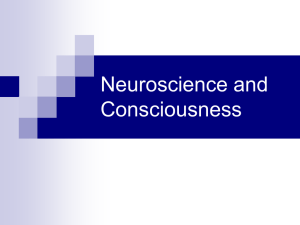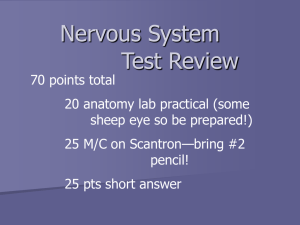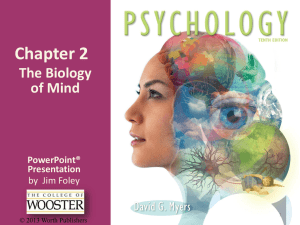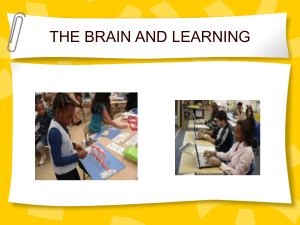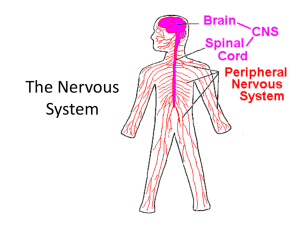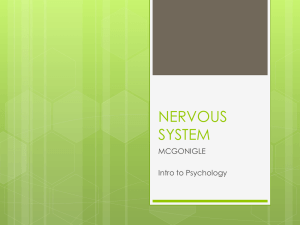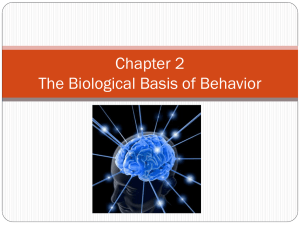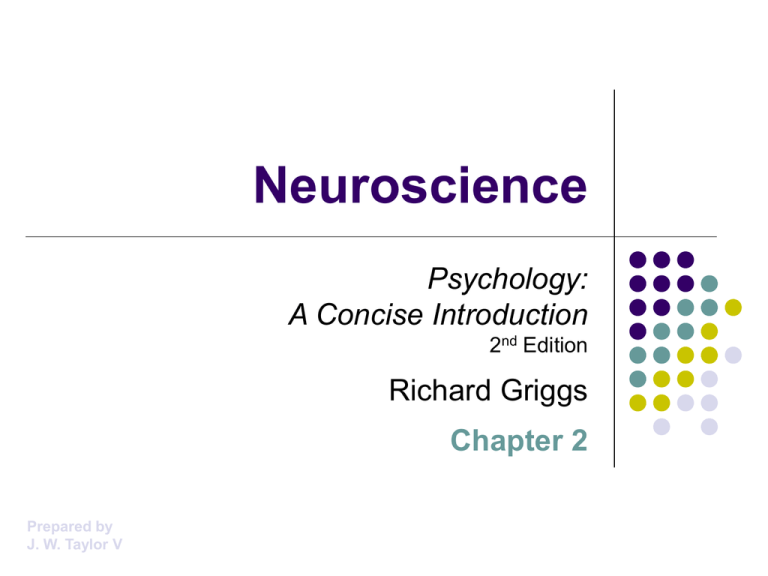
Neuroscience
Psychology:
A Concise Introduction
2nd Edition
Richard Griggs
Chapter 2
Prepared by
J. W. Taylor V
The Journey…
The
Neuron
The
Nervous
System and the
Endocrine System
The
Brain
The Neuron
The Structure of a Neuron
How Neurons Communicate
Neurotransmitters,
Drugs, and Poisons
Neurons and Glial Cells
Neurons are responsible for information
transmission throughout the nervous system
Glial cells do not directly transmit
information, but instead support neurons in
their work by disposing of waste products of
neurons, keeping their
chemical environment
stable, and insulating
them
The Structure of a Neuron
Dendrites are the fibers that
project out of the cell body,
receiving information from other
neurons
The cell body contains the
nucleus of the cell and other
biological machinery to keep the
cell alive
The axon transmits messages
through the neuron
The axon terminals are at the
end of the axon and send
messages to a different neuron
The Structure of a Neuron
How Neurons Communicate
Communication
within
a neuron is
electrical
Communication
between
neurons is
chemical
The Electrical Impulse
Information from the dendrites is either
excitatory (telling the neuron to generate an
electrical impulse) or inhibitory (telling the
neuron not to generate an electrical impulse)
The impulse is an “all or nothing” event, meaning
that there either is or is not an electrical impulse
Stimuli of varying intensities are encoded by the
quantity of neurons generating impulses and the
number of impulses generated each second by
the neurons
The Electrical Impulse
The myelin sheath is an insulating layer of
fatty white substance that encases the axon,
allowing electrical message to be transmitted
faster within the neuron
Damage to the myelin sheath will slow
electrical impulses, and can result in diseases
like multiple sclerosis
Chemical Communication
Between Neurons
Axon terminals contains sacs of
neurotransmitters
These neurotransmitters are naturally occurring
chemicals in the nervous system that specialize in
transmitting information between neurons
Between the axon terminals of one neuron
and the dendrites of another neuron is a
small space called the synaptic gap, across
which neurotransmitters are sent, allowing
neurons to communicate
Brain Scans
Brain scans work because neurons require
oxygen and other nutrients such as blood
sugar
Positron Emission Tomography (PET) scans
use a dose of radioactive glucose, which moves
to the more-active areas of the brain
Functional Magnetic Resonance Imaging
(MRI) detects active areas of the brain by
highlighting those areas that require more
oxygen
Neurotransmitters,
Drugs, and Poisons
Key terms:
Agonists
Antagonists
Drugs and poisons
that increase the
activity of one or more
neurotransmitters
Drugs and poisons
that decrease the
activity of one or more
neurotransmitters
Neurotransmitters
1. Acetylcholine (ACh) is involved in both learning and
memory and muscle movement
2. Dopmaine impacts our arousal and mood states, thought
processes, and physical movement
3. Serotonin and norepinephrine are neurotransmitters
involved in levels of arousal and mood, and play a major
role in mood disorders such as depression
4. GABA is the main inhibitory neurotransmitter in the
nervous system; glutamate is the main excitatory
neurotransmitter
5. Endorphins are a group of neurotransmitters that are
involved in pain perception and relief
Acetylcholine (ACh)
Botulinum poison (botulin) is an antagonist that
blocks the release of ACh at muscle junctures,
leading to paralysis and even death
Curare is an antagonist that paralyzes the body by
occupying the receptor sites for ACh, thereby
preventing ACh from getting in and carrying its
message to a neuron
Black widow spider venom is an agonist for Ach,
causing the continuous release of ACh, flooding the
synapse
Dopamine
Low levels are associated
with Parkinson’s disease,
and excessively high levels
are associated with schizophrenia
L-Dopa is an agonist that increases production of
dopamine
Anti-psychotic drugs are antagonists that block the
receptor sites for dopamine so that this neurotransmitter
cannot send its messages
Amphetamine acts as an agonist by stimulating the
release of dopamine from axon terminals
Cocaine is an agonist that blocks the re-uptake of
dopamine
Serotonin and Norepinephrine
Some antidepressant drugs work by blocking
the reuptake of serotonin and norepinephine
Anti-depressant drugs like Prozac, Paxil,
and Zoloft are selective serotonin reuptake
inhibitors
GABA and Glutamate
Anti-anxiety drugs are agonists for GABA
Lack of GABA may contribute to epilepsy, a
brain disorder resulting in uncontrolled
movement and convulsions
Glutamate is involved in memory storage
and pain perception.
Excessive glutamate can lead to neuron
death; deficient glutamate has been
proposed to explain schizophrenia
Endorphins
Morphine and heroin are agonists that bind
to receptor sites, thereby increasing
endorphin activity
The Nervous and
Endocrine Systems
The Central Nervous System
The Peripheral Nervous System
The Endocrine Glandular System
Emotions and the
Autonomic Nervous System
Nervous System Subdivisions
Types of Neurons
Interneurons exist only in the central
nervous system
Sensory neurons carry information to the
central nervous system from sensory
receptors in the eyes, muscles, and glands
Motor neurons carry movement commands
from the central nervous system to the rest of
the body
The Central Nervous System
Consists of the spinal cord and the brain
The spinal cord has two functions
Conduit for incoming sensory data
and outgoing movement commands
Provides for spinal reflexes, which
are simple automatic actions not
involving the brain
The brain is the control center for the
entire nervous system
The Peripheral Nervous System
Gathers information about the external
environment and the body’s internal
environment for the brain through sensory
neurons
Serves as the conduit for the brain’s
commands to the rest of the body through
motor neurons
The Peripheral Nervous System
Consists of two parts:
The somatic (or skeletal) nervous system carries
sensory input from receptors to the CNS and relays
commands from the CNS to the skeletal muscles to control
their movement
The autonomic nervous system regulates our internal
environment and consists of two parts
The sympathetic nervous system is in control when we
are very aroused and prepares us for defensive action
(such as running away or fighting)
The parasympathetic nervous system is in control when
the aroused state ends to return our body to its normal
resting state
The Endocrine Glandular System
Not part of the nervous system
Works with the autonomic nervous system in
responding to stress, and plays a role in basic
behaviors and bodily functions such as sex,
eating, metabolism, reproduction, and growth
Endocrine glands secret hormones, which are
chemicals carried by the bloodstream to target
sites throughout the body
The Endocrine Glandular System
Endocrine glands are controlled by the
hypothalamus, which controls the most influential
gland, the pituitary
Releases hormones essential for human growth and that
direct other glands to release their hormones
Some other glands:
Thyroid gland affects our growth and maturation
Adrenal glands are involved in metabolism and help
trigger the “fight or flight” response with commands from
the autonomic nervous system
The pancreas is involved in digestion and maintaining
blood-sugar levels
The Endocrine Glandular System
Components of Emotion
An emotion is a complex psychological
state that involves three components:
Physical
Behavioral
Cognitive
A physiological
state of arousal
triggered by the
autonomic
nervous system
An outward
expression including
facial expressions,
movements and
gestures
An appraisal of the
situation to determine
which emotion we are
experiencing and how
intensely
Components of Emotion
The physical component
The behavioral component
Includes the “fight or flight” response of the autonomic nervous
system
Heart rate and breathing increase, blood pressure surges, start
sweating, pupils dilate, digestion slows
Is the product of motor neurons
The facial-feedback hypothesis assumes that the facial muscles
send messages to the brain, allowing the brain to determine
which emotion is being experienced
The cognitive component
Includes an appraisal of the situation to determine what emotion
we are experiencing
Theories of Emotion
James-Lange Theory
Cannon-Bard Theory
Schachter-Singer
Two-Factor Theory
James-Lange Theory
Contends that autonomic nervous system
physiological arousal is a response to a stimulus, and
that such a physiological response is subsequently
interpreted as the emotion
For example, if you are crossing
the street and see a car speeding
toward you, your autonomic
nervous system is aroused (e.g.,
increased heart rate). Based on
this arousal, you interpret the
stimulus as threatening and pick
up your pace across the street.
Cannon-Bard Theory
Contends that arousal patterns for different
emotions are too physiologically alike to be
able to determine what emotion is being
experienced
Instead, an emotion-provoking stimulus
sends messages to both the peripheral
nervous system and the brain
The brain produces the emotional feeling, the
autonomic nervous system produces the
physiological response, and the motor neurons
produce the behavioral response
Schachter-Singer
Two-Factor Theory
Contends that there are two important
determinants of emotion:
Physiological arousal tells us how intense the
emotion is
The cognitive appraisal of the entire situation
allows us to identify the emotion, leading to the
emotional feeling
Integrating the Theories
LeDoux (1996) contends that there are
different brain systems for different emotions
Fear, for example, does not require higher-level
cognitive processing and is generated almost
instantaneously by the amygdala
More complex emotions, however, such as love
or guilt, that do not require instantaneous
responding for survival, may require higher-level
processing
The Brain
Going up the Brain Stem
Processing in the Cerebral Cortex
Specializations of the
Left and Right Hemispheres
Consciousness and
the Sleeping Brain
Case 1: A Landscape Artist
Scenario
Anne the
landscape
artist is
standing at her
easel, painting
with her right
hand as she
looks out the
window at her
garden. She’s
listening to
classical
music as she
paints.
Neuroanatomy
Left motor cortex
Left frontal lobe
Visual cortex
Both occipital lobes
Auditory cortexes
Both temporal lobes
Right hemisphere
Thalamus
Frontal lobes
Left sensory cortex
Left parietal lobe
Cerebellum
Related Function
Controls right hand
Contains motor cortex
Used for vision
Contain visual cortex
Used to hear music
Contain auditory cortexes
Spatial ability for painting
Relays sensory information
Deciding what to paint
Feeling the paintbrush
Contains sensory cortex
Coordinates moving arm
Case 2: A Professional Wrestler
Scenario
Crazy Eddie, the
professional
wrestler, is in the
ring wrestling. The
crowd is yelling
and his is taunting
him. Eddie yells
back at his
opponent. The two
of them are out of
breath and
sweating
profusely. They
continue their
well-orchestrated
series of wrestling
moves.
Neuroanatomy
Both motor cortexes
Frontal lobes
Both sensory cortexes
Parietal lobes
Visual cortexes
Both occipital lobes
Right hemisphere
Wernicke’s area
Left temporal lobe
Broca’s area
Left frontal lobe
Thalamus
Frontal lobes
Medulla
Amygdala
Reticular formation
Cerebellum
Hypothalamus
Hippocampus
Related Function
Move muscles
Contain motor cortexes
Needed for sense of touch
Contain sensory cortexes
Used for vision
Contain visual cortexes
Spatial ability for wrestling
Understanding taunts
Contains Wernicke’s area
Produces speech (yells)
Contains Broca’s area
Sensory relay
Decision making & attention
Regulates heart and breathing
Aggression and fear
Controls arousal
Balance and coordination
Regulates temperature
Memory for moves
Case 3: A Student
Scenario
Jill is a law
student
studying for
her exam. She
is reading
about violent
rape and
murder cases.
She is snacking
on popcorn
and drinking
coffee.
Neuroanatomy
Related Function
Hippocampus
Remembering and learning
Wernicke’s area
Language comprehension
Left temporal lobe
Contains Wernicke’s area
Amygdala
Anger and fear about cases
Frontal lobes
Decision making & attention
Hypothalamus
Regulates hunger and thirst
Angular gyrus
Needed for reading
Source: Sheldon, J. P. (2000). A neuroanatomy teaching activity using case studies and collaboration.
Teaching of Psychology, 27, 126-128.
The Central Core
The brain stem
The medulla links the spinal cord to the brain and is involved in
regulating heartbeat, blood pressure, digestion, and swallowing
The reticular formation is a network of neurons running up the
center of the brain stem and into the thalamus that is involved in
controlling our different levels of arousal and awareness
The cerebellum is involved in the coordination of our
movements, our sense of balance, and motor and
procedural learning
The thalamus, located at the top of the brain stem,
serves as a relay station for incoming sensory
information (except smell)
The basal ganglia are on the outer sides of the thamalus and are
concerned mainly with the initiation and execution of physical
movements
The Central
Core Brain
Structures
The Limbic System
Plays a role in our survival, memory, and
emotions
The hypothalamus control the pituitary gland,
the autonomic nervous system, and plays a
major role in regulating basic drives such as
eating, thirst, and sex
The hippocampus is involved in the formation
of memories
The amygdala plays a major role in regulating
our emotional experiences, especially fear,
anger, and aggression
The Limbic System
Processing in
the Cerebral Cortex
The cerebral cortex
is the most important
brain structure, serving
as the information
processing center for
the nervous system
Is where perception, language, memory, decision
making, and all other higher-level cognitive processing
occur
Consists of two hemispheres connected by a band of
neurons called the corpus callosum, allowing the two
hemispheres to communicate
Brain Lobes
1. The frontal lobe is the area in the
front of each hemisphere and in front of
the central fissure and above the lateral
fissure
2. The parietal lobe is the area located
behind the central fissure and above the
lateral fissure
3. The temporal lobe is located beneath
the lateral fissure
4. The occipital lobe is located in the
lower back of each hemisphere
The Four Lobes and the
Sensory-Motor Processing Areas
The Motor Cortex
The frontal lobe strip of cortex, directly in front
of the central fissure in each hemisphere,
allows us to move different parts of our body
Each hemisphere controls the voluntary
movement of the opposite side of the
body (a contralateral relationship)
Amount of motor cortex devoted to a
specific body part is related to the
complexity and precision of movement
of which that part is capable
The Somatosensory Cortex
The parietal lobe strip of cortex, directly
behind the central fissure in each
hemisphere, is where body sensations
of pressure, temperature, limb
position, and pain are processed
Contralateral relationship
Amount of sensorimotor cortex devoted
to a body part is directly proportionate to
the sensitivity of that body part
Homunculi for the Motor Cortex
and the Somatosensory Cortex
Visual Cortex
and Auditory Cortex
The visual cortex is located in the occipital lobes at
the back of the hemispheres
The auditory cortex is in the temporal lobes
These primary areas pass the
results of their analyses on to
areas in the other lobes to complete
the brain’s interpretation of the
incoming visual or auditory information
These secondary cortical processing
areas are part of what is termed the
association cortex
Association Cortex
Consists of the other 70% of the cortex not
in one of the previously mentioned areas
This is where the higher-level processing
such as decision making, reasoning,
perception, speech, and language occurs
All of which require integration of various types
of information
The Case of Phineas Gage
Phineas Gage was railroad worker
who survived when a metal tamping
iron flew through his left cheek and
head, exiting through his frontal
lobes
He became irresponsible,
impulsive, disorderly, indecisive,
and cursed, leading neuroscientists
to think the frontal lobes are
important in such behaviors
Language
Broca’s area, in the left hemisphere’s temporal
lobe, is responsible for fluent speech production
When damaged, people cannot generate fluent speech,
but can still understand speech easily
Singing and musical abilities seem to be housed in the
right hemisphere because damage to Broca’s area does
not impair these abilities
Wernicke’s area is in the left temporal lobe and is
responsible for the comprehension of speech and
reading
Language
Studying the Two Hemispheres
Light waves from the left visual field go to the
right half of each eye, and light waves from the
right visual field go to the left half of each eye
The right half of each eye connects with the
right hemisphere, and the left half of each eye
connects with the left hemisphere
Pathways for
Processing
Information
in the Left
and Right
Visual Fields
Studying the Two Hemispheres
With split-brained people, the information
cannot transfer between hemispheres
because the corpus callosum has been cut
Split-brain people can only identify
information orally when it is presented
briefly in the right visual field (and thus
processing in the left hemisphere)
If a spoon was flashed in the left visual
field, split-brained people could not say it
was a spoon
If the person was blind-folded and told to
find the object from a group of objects
with the left hand, s/he can do this
What we know…
Left hemisphere
Language
Math and logic skills
More analytical, analyzing wholes into pieces
Right hemisphere
Spatial perception
Solving spatial problems
Drawing
Face recognition
What we know…
Remember, however, that these differences
in hemispheric performance are for people
whose two hemispheres can no longer
communicate
When normal people are performing a task,
the two hemispheres are constantly
interacting and sharing information
This is why it is not very accurate to say
someone is “left-brained” or “right-brained”
Rather, nearly all of us are “whole brained”
Consciousness
and the Sleeping Brain
Consciousness is a person’s subjective awareness
of both their inner thinking and feeling and their
external environment
The five stages of sleep were determined by use of
an electroencephalogram (EEG), which records a
real-time graph of a person’s cortical electrical
activity in the brain
As we slip into sleep and pass through the first four
stages, our brain waves change, in general becoming
progressively slower, larger, and more irregular, especially
in Stages 3 and 4
Five Stages of Sleep
Stage 1: Lasts about 5 minutes
Stage 2: Lasts about 20 minutes
Characterized by sleep spindles, rapid bursts of
mental activity
Stage 3: Also known as transitional sleep
and is characterized by delta waves, which
are large, slow waves
Stage 4: Lasts about 30 minutes
Parasympathetic nervous system is active, as
muscles relax, heartbeat slows, blood pressure
declines, and digestion speeds up
Five Stages of Sleep
Stage 5: REM (rapid eye movement sleep) occurs
after we leave stage 4 sleep and return through the
earlier stages of sleep
Called paradoxical sleep because your muscles are relaxed, but
other body systems, including the brain, are active, much like a
waking pattern
Characterized by very rapid brain waves somewhat like those of
Stage 1 sleep, but one is still sound asleep
If awakened during REM sleep, people often report having been
dreaming
Most dreams are emotional and unpleasant, perhaps because
the visual cortex and frontal lobe are inactive during REM sleep;
the limbic system structures are active, however, creating
irrational imagery and emotional experiences of our dream world
REM sleep accounts for 20–25% of total sleep time
Five
Stages
of Sleep
Five Stages of Sleep
These 5 stages (the sleep cycle) repeat
themselves about every 90 minutes, with
Stages 3 and 4 getting shorter with each cycle,
and REM and Stage 2 getting longer with each
cycle
REM sleep rebound effect is a significant
increase in the proportion of REM sleep
following deprivation of REM sleep
Why do we sleep and dream?
Sleep deprivation results in:
Impaired concentration and a general bodily feeling of
weakness and discomfort
Suppression of the immune system, lessening one’s
ability to fight off infection and disease
Increased vulnerability to accidents
Increased difficulty in concentrating, studying, and
taking exams
Why do we sleep and dream?
Explanations for dreaming :
Sigmund Freud proposed that dreams were
disguised outlets for inner conflicts of our
unconscious mind, a view not accepted by modern
sleep researchers
The activation-synthesis hypothesis contends that
dreams are merely the sleeping brain’s attempt to
make sense of random neural activity without the
rational interpretation of the frontal lobe




